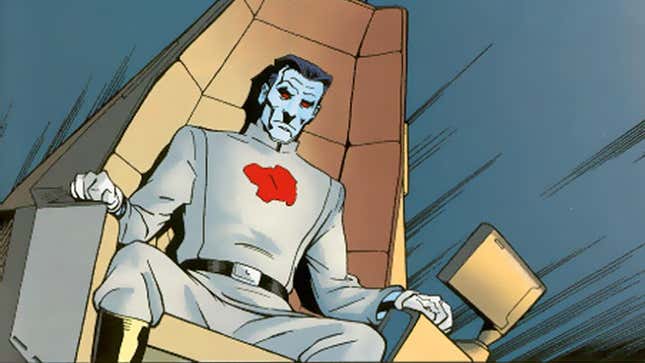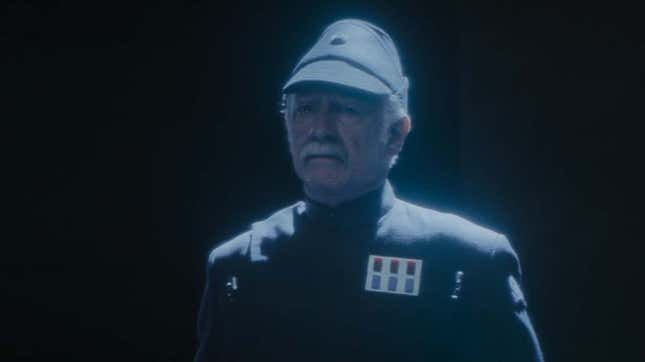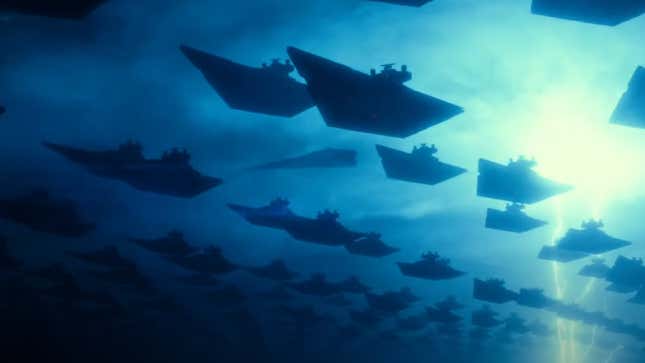
“Thrawn’s return... as Heir to the Empire.” In just seven words, Ahsoka’s first trailer made clear the desires fans have yearned for since a blue-skinned man in a white admiral’s uniform first stepped out of the shadows six years prior: Thrawn is here, and Heir to the Empire, the novel that started it all decades before, is coming with him in some manner.
It’s impossible for a million reasons for the current iteration of Star Wars canon to remake Timothy Zahn’s classic trilogy of books—Heir, Dark Force Rising, and The Last Command—wholesale. Too many elements have already been plundered and shifted about in Star Wars’ present continuity, Thrawn himself included, and just as many are as impossible to re-work for the direction the franchise has now taken the post-Return of the Jedi story. Although we know little at this point, it’s likely that whatever Ahsoka and the Dave Filoni-helmed New Republic vs. Imperial Remnant movie set to come after it will have little in common with Heir to the Empire’s narrative—beyond that teasing name drop, and the macro-scale fact that it will deal with Thrawn commanding a sea of remnant forces in a military campaign against the New Republic.
But that doesn’t really matter, because in a way, that’s really all you need to take to do a new version of this story. Because in the end, Thrawn himself doesn’t really matter beyond that specific story being told. Why? Spoilers for a novel that turned 30 at the start of this month: Thrawn dies at the climax of The Last Command. He is a major threat for those three books, and then he is gone.

This is not a knock on the character of Thrawn, or the legions of fans that have come to be fascinated by the character in the decades since his rapid rise and fall over the barely two years it took the Thrawn trilogy to release. He is beloved for a reason, and Zahn created such an impactful and intriguing villain that his reach has stretched far beyond the character’s short, active lifespan in Star Wars fiction. That reach has now expanded into the current continuity as well, not just in Rebels and soon Ahsoka, but Zahn’s further exploration of the Grand Admiral’s life in the new Thrawn trilogy and its prequel follow up, the Thrawn: Ascendancy novels. But for as fascinating and enduring a character and piece of iconography that Thrawn is, and for as rightly beloved as those first novels with him are, what was always the compelling thing about the Heir to the Empire saga was not necessarily the saga itself, but the state of the Star Wars galaxy it set up for decades thereafter, especially when it came to the vestiges of the Galactic Empire.
Thrawn’s defeat at Bilbringi—assassinated by his once-loyal guard, his grasp of the Emperor’s cloning technology thwarted, his forces routed, and, now under the command of his still-faithful comrade Captain Gilad Pellaeon, returned to the lingering control of the latest form of the Empire’s ruling council—brings to an abrupt end the life of a Star Wars villain that has since become much larger in the minds of fans that it ever really was in the fiction itself. Zahn’s trilogy books weren’t Thrawn’s only appearances, of course. The later Hand of Thrawn duology touches on the Grand Admiral’s seeming resurrection, and the novel Outbound Flight fleshed out Thrawn’s relationship with the Jedi Jorus C’baoth, in a prequel setting. But Thrawn himself, albeit an incredibly compelling character, was never the most interesting thing that his trilogy set up. It couldn’t be; he was dead and gone by its final pages. What was truly fascinating, and what can’t really grok into the current timeline of Star Wars, is what came after.

That largely comes through in another element current Star Wars canon is borrowing for this new version of the tale: Captain Pellaeon. Thrawn’s most trusted advisor and the de facto commander of his forces after his death, Pellaeon’s post-Thrawn arc is the arc of the Imperial Remnant itself for decades. The timeline of the post-ROTJ state of the galaxy in the old Expanded Universe is much more drawn out than it is in the current continuity, and Pellaeon is there for much of it. The galactic civil war takes almost two decades to end in the EU compared to the five years it finishes in at the battle of Jakku in the current canon, giving time for the Imperial Remnant to be fleshed out in a much deeper and more compelling manner. Pellaeon, in various roles, helps transform the Remnant into the galactic equivalent of a neighboring state. Although elements of the antagonism and greed that sparked the rebellion against Palpatine in the first place still linger, the Remnant of the old EU was forced to become introspective, to learn just what vile history Palapatine made and what parts of that history needed to be reckoned with for this new political entity to survive beyond it. In time, the Imperial Remnant became an occasionally wary ally of the New Republic, aiding in the battle against the Yuuzhan Vong, and in more time, eventually merged back into it with the decline of both entities and the creation of the Galactic Alliance.
This luxury of time and growth is not something current continuity has. There’s 30 years between Return of the Jedi and The Force Awakens, yes. But in the bulk of that time the remnant we’ve seen growing in The Mandalorian, and whatever is to come with Thrawn’s campaigns in Ahsoka and beyond, has to be smashed aside for the creation of the First Order—which, in stark contrast, is just the Empire again. And even that then has to be smashed aside for the Final Order in The Rise of Skywalker, which is even more just the Empire again, literally right down to the old Star Destroyers and older Palpatine at its helm. In current continuity, there is no real space for the introspection and evolution of the Imperial Remnant as seen in the old EU, and no space to examine that whatever military strike Thrawn will execute—and see inevitably quashed—in this New Republic vs Remnant conflict to come was not the path to the Empire’s survival. And it doesn’t need to, because we know the Empire survives without that introspection in the shadows of the Unknown Regions anyway, only to be just as easily quashed in generations to come.

That’s not to say there can’t be something like this in current Star Wars canon, just removed much farther away from the Empire and the events of the original trilogy. If Lucasfilm actually manages to commit to finishing an announced film project—which has been surprisingly difficult as of late—we’re on the cusp of getting a continuation of The Rise of Skywalker in the form of a New Jedi Order movie, which will no doubt have to deal with at least some of the fallout of the First and Final Order’s remnants in the wake of the sequel trilogy. But that’s only really similar in spirit, and carries a much more awkward weight of grappling with those movies’ villainous factions compared to the direct examination of the original Galactic Empire.
It is that legacy that is perhaps more important from Heir to the Empire and its follow-ups that was far more important to the longevity of the old Expanded Universe than Thrawn himself ever directly was. And no matter what Ahsoka and its follow ups will borrow from it, it’s something that the current Star Wars galaxy can never really re-capture.
Want more io9 news? Check out when to expect the latest Marvel, Star Wars, and Star Trek releases, what’s next for the DC Universe on film and TV, and everything you need to know about the future of Doctor Who.

